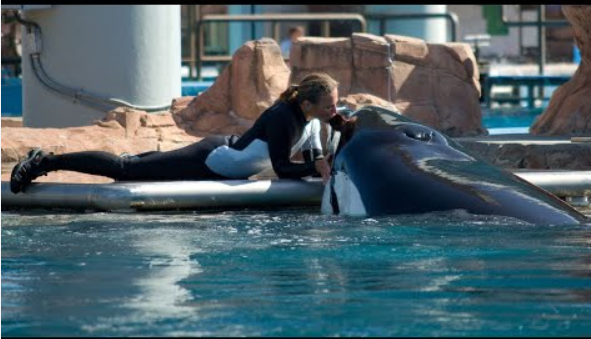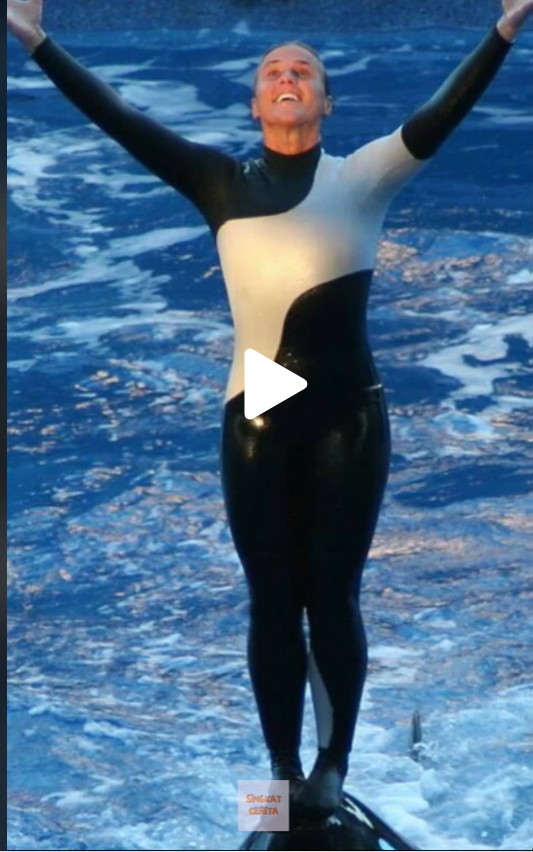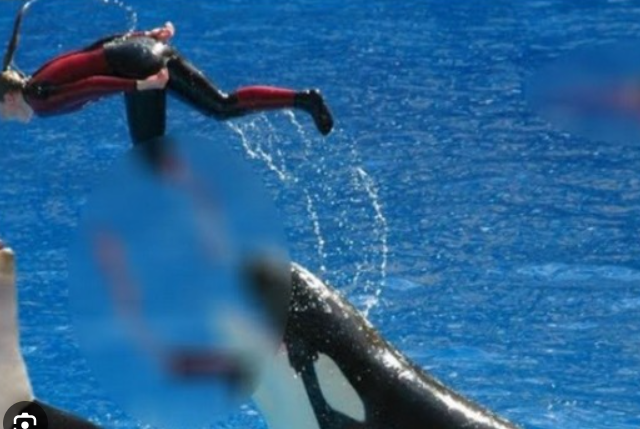In the world of marine entertainment and captive animal performances, there exists a haunting and profoundly somber moment forever etched in the collective memory of those who witnessed it – the “Dawn Brancheau Ponytail Video.” This footage, both chilling and heartbreaking, provides a gripping account of an incident that took place at SeaWorld, Orlando, an event that would irrevocably change the way we view the relationship between humans and marine animals.
The video captures the final moments before a tragic and fatal attack, one that would leave an indelible mark on the captive animal industry and society as a whole. At its center is a devoted and experienced trainer, Dawn Brancheau, whose life was tragically cut short during a performance with Tilikum, one of SeaWorld’s largest orcas. This video offers an unfiltered view of the unforeseen tragedy that unfolded in front of an unsuspecting audience, sparking a series of responses and discussions about ethics, animal welfare, and the complex dynamics of human-animal interaction.
In this exploration, we delve deep into the heart-wrenching details of the “Dawn Brancheau Ponytail Video,” uncovering not just the incident itself but the repercussions it had on SeaWorld, the legal battles that followed, the wave of public outcry and activism, and the profound impact it left on the captive animal industry. It is a story that reminds us of the unpredictability inherent in working with wild animals and prompts essential conversations about the role of safety protocols, the ethics of captivity, and the pursuit of a more compassionate approach to our fellow creatures who share this planet with us.

I. The Incident
On February 24, 2010, during a “Dine with Shamu” show at SeaWorld, tragedy struck. Dawn Brancheau, a highly experienced and beloved trainer, was performing alongside Tilikum, one of SeaWorld’s largest orcas. Everything seemed normal, and the audience watched in awe as Dawn interacted with the massive creature.
However, the video reveals a horrifying moment. Dawn Brancheau’s long ponytail unexpectedly slipped into Tilikum’s mouth. What happened next was a brutal and tragic attack, during which the orca pulled Dawn underwater, causing fatal injuries.
The “Dawn Brancheau Ponytail Video” shows the stark reality of the inherent dangers involved in working with wild animals, even those in captivity. It serves as a chilling reminder of the unpredictable nature of such interactions.

II. Immediate Aftermath
The incident shook SeaWorld and the world at large. There was an outpouring of grief for Dawn Brancheau, who was widely regarded as a passionate and dedicated trainer. SeaWorld immediately closed its doors to visitors and faced extensive media coverage and public scrutiny.
III. Responses and Repercussions
- SeaWorld’s Response: In the wake of the incident, SeaWorld conducted an internal investigation to determine the cause and contributing factors. This internal review was an attempt to shed light on what went wrong during the interaction between Dawn and Tilikum. As a result of the investigation, SeaWorld implemented new safety protocols and training procedures for their trainers. They also made significant changes to their whale show performances, including the removal of certain elements that could potentially put trainers at risk. These changes were essential for preventing future incidents.
- Government Investigations: In addition to SeaWorld’s internal investigation, governing authorities, such as the Occupational Safety and Health Administration (OSHA), launched their own investigations. OSHA ultimately issued citations and fines against SeaWorld for safety violations, leading to a legal battle between the company and the regulatory agency. These investigations were crucial in holding SeaWorld accountable for the safety of its trainers and the animals under its care.

Dawn Brancheau ponytail video
IV. Public Outcry and Activism
The release of the “Dawn Brancheau Ponytail Video” sparked a wave of public outcry and activism. Many people were shocked and disturbed by the footage, leading to increased scrutiny and criticism of SeaWorld and similar facilities that keep marine animals in captivity.
Animal rights organizations, such as PETA (People for the Ethical Treatment of Animals), seized this opportunity to raise awareness about the ethical implications of keeping animals in captivity for entertainment purposes. They organized protests, public campaigns, and social media initiatives to advocate for the end of killer whale shows and the retirement of captive orcas to sanctuaries.

V. Legal Ramifications
The tragic incident also resulted in legal ramifications for SeaWorld. Following the investigation by OSHA and the subsequent citations for safety violations, SeaWorld reached a settlement agreement with the regulatory agency. As part of the settlement, SeaWorld agreed to improve safety measures and training protocols, as well as pay a significant fine.
Furthermore, the incident and the ensuing public backlash led to proposed legislation in several states that aimed to ban or severely restrict the captivity and performance of marine mammals, particularly killer whales. These proposed laws sought to ensure the welfare and safety of both animals and trainers.
VI. Impact on the Captive Animal Industry
The “Dawn Brancheau Ponytail Video” had a far-reaching impact on the captive animal industry as a whole. It became a turning point in public perception and raised significant ethical questions about the practice of keeping wild animals in captivity for entertainment purposes.
Many people began to question the ethical implications of confining large, highly intelligent animals like orcas in small tanks for their entire lives. They started to recognize the potential psychological and physical harm that captivity can inflict on these animals, leading to a shift in attitudes towards marine parks and similar facilities.
Additionally, the incident highlighted the importance of adequate training, safety protocols, and risk assessment when working with dangerous animals. It brought to the forefront the need for stricter regulations and oversight to ensure the well-being of both the animals and the trainers.
VII. Conclusion
The “Dawn Brancheau Ponytail Video” had a profound and lasting impact on the captive animal industry, sparking important discussions about the ethics of captivity and the treatment of animals in entertainment settings. It brought attention to the risks and potential dangers associated with working with wild animals, raising questions about safety protocols and training practices. It also ignited public outcry and activism, leading to increased scrutiny of marine parks and calls for the end of keeping animals like killer whales in captivity for human entertainment. The incident served as a pivotal moment in the ongoing efforts to safeguard and respect wildlife on our planet, reminding us of the complex and unpredictable nature of human-animal interactions.
Frequently Asked Questions
- **What happened in the “Dawn Brancheau Ponytail Video”?
- The “Dawn Brancheau Ponytail Video” captured the final moments before the tragic attack by the killer whale Tilikum at SeaWorld. It shows trainer Dawn Brancheau engaging in what seemed to be a joyful interaction with the whale before her ponytail fell in front of Tilikum, leading to the sudden attack.
- **How did the “Dawn Brancheau Ponytail Video” impact SeaWorld?
- The video sparked swift responses from SeaWorld, including an internal investigation, implementation of new safety protocols, and changes to their whale show performances. SeaWorld also faced legal ramifications and public backlash, leading to increased scrutiny and calls for the end of killer whale shows.
- **What were the legal consequences of the incident?
- Following an investigation by OSHA, SeaWorld was issued citations and fines for safety violations. This led to a settlement agreement between SeaWorld and OSHA, which included improvements in safety measures, training protocols, and a significant fine.
- **How did the incident impact the public perception of captive animal facilities?
- The incident raised significant ethical questions about the practice of keeping wild animals in captivity for entertainment purposes. It led to increased scrutiny of marine parks and brought attention to the potential harm inflicted on animals in confinement. Many people started questioning the ethics of keeping large, intelligent animals like orcas in small tanks.
- **What kind of activism did the “Dawn Brancheau Ponytail Video” inspire?
- The video sparked public outcry and activism, particularly from animal rights organizations like PETA. They organized protests, public campaigns, and social media initiatives to advocate for the end of killer whale shows and the retirement of captive orcas to sanctuaries.
